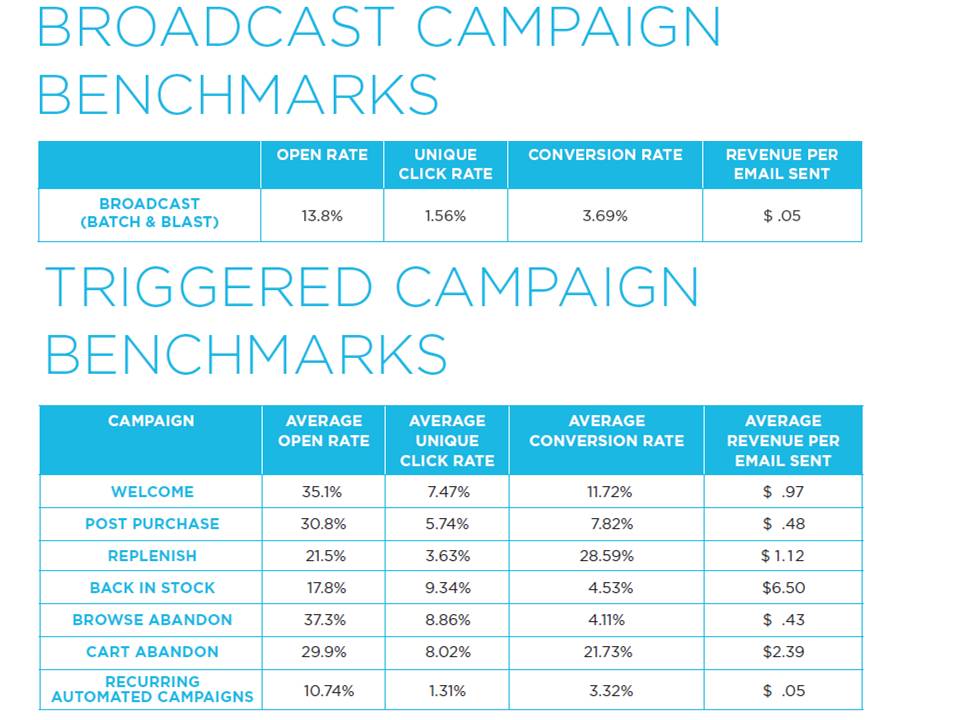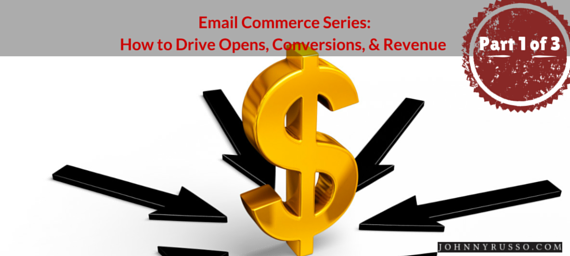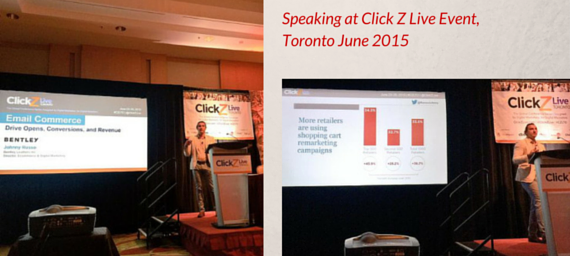On June 24-25, 2015 I was asked to speak at ClickZ Live in Toronto about driving email revenue. It was a good digital conference with some powerful brands in attendance. This blog post is a summary of what I spoke about. This is a series of 3 emails on driving email commerce. This is the first email in the series, which will outline potential welcome and cart abandonment email strategies.
In the last few years, many marketing pundits have declared email alive, dead, alive again, and dead again. Well, Email is very much alive and should be a healthy source of Ecommerce revenue and traffic for your site. But how do you effectively drive email revenue? How do you do that when talking about email, especially when much of email is not personalized for each stage of the buying cycle or purchase phase?
Well, I think we can all agree that when it comes to email, for the most part, your goal is to move a customer from awareness and consideration, to conversion and loyalty.
Eliminate the Need to Always Send Mass Emails
Now here’s the problem: boring, mass emails! When you send mass emails – that is, an eblast to your entire list or database with little targeting and no segmentation – your email analytics look the same. It’s a similar open rate, with a similar click-through rate (CTR), and an average conversion rate. We all sit there and wait for a date, a send time, and push the magic button to deliver thousands of the same email to different customers. No wonder marketing teams pull their hair out and depend on an email automation tool to save them, but what about outlining a strategy first? A great tool with a poor strategy (i.e. mass email sends at all times) will get you nowhere.
Consider that, in one form or another, the Email Marketing channel, made up of forms of broadcast, personalized, triggered, and/or transactional emails, should account for approximately 25% of your overall Ecommerce revenue and you have a business case to be so much more creative and thoughtful when it comes to email.
Think about this: If 2% of people buy on your site (why is a typical Ecommerce conversion rate), that means that 98% of them don’t. Simple math, right? Of those 98%, 80% of them abandon their cart (another Ecommerce average). If you can capture a large percentage of the abandoners’ email addresses, it’s quite the opportunity to “recover” their sale with an abandoned cart series. Even if you only convert 20% of the 80%, which is a solid cart abandonment conversion, you’ll get a raise. So let’s get into how to do this.
Welcome to Our Newsletter. Now What?
So now we get into some of the more refined and focused strategies. According to Blue Hornet, 76% of customers expect to get a Welcome email when they sign up to receive newsletters. That is great news.
This is your opportunity to tell them a story. And you don’t need to just stop at 1 welcome message. This is your chance to make your brand stand out.
The numbers don’t lie. Listrak, an Omni-Channel Email solutions provider (transparency: I am a Listrak customer), performed an Email benchmark report that was released in March 2015. Below are some of the staggering stats.

While we’ll touch on some of the other lesser-known triggered emails in part 2 of this Email Commerce Series, it’s important to underscore the staggering average open rates (35.1%) for Welcome Emails, not to mention a conversion rate of 11.72%.
Here’s how you can go about your own Welcome series. Why not design a Welcome series consisting of 3 emails. The first one could be your typical Welcome offer: “Get 15% off your next purchase.” Be sure to include a promo code or some other tracking mechanism so you know if the Welcome offer is working. Try to add a sense of urgency by including an end date to the Welcome offer, typically about 30 days after send. If you have stores, work with the stores operations team to see how they can use the offer in-stores, perhaps it’s as simple as attaching a bar code or QR (quick response) code at the footer of the email. Another helpful hint: people expect the Welcome offer to immediately hit their inbox once they subscribe. Be sure your email tool can support that.
The second email in the Welcome series can tell your brand story. When you were founded? How many stores do you have? How many employees work for your company? How about celebrities? Do they wear your clothes or use the items you sell? What are your value propositions? What sets your brand apart from any other businesses that offer similar products and services? What is your unique story? Tell is, and tell it well. Make that early brand impression count.
The third email should be centered on the brands you carry, or the categories or products you sell, or the services you offer. However, don’t ask for the sale yet. Just showcase the items. Describe them. Don’t be pushy just yet. Lead them down your journey. Make your subscribers understand that you are the only destination they should be considering.
The Welcome Series does convert well, but this series should be about telling them your brand story and be sure to include some value propositions in there as well. Here are some other things you can include in the Welcome series:
- Proactive information to prevent post-purchase confusion or problems (ex. shipping fees)
- FAQ link
- Incentive for future purchase
- Contact information for questions or issues (your 1-800 number perhaps)
- Live chat link
Turn Abandoned Cart Into A Good Thing
We’re in 2015, so most, if not all, digital marketers should be familiar with abandoned cart. There are a number of reasons for visitors to abandonment a cart on a website: shipping costs too high or not apparent, a complex checkout process, lack of payment options, visitors are price or comparison shopping, account sign in is too long or complex, or they are simply hoping for an offer or discount down the line. Here’s the good news – cart abandonment can lead your email campaigns in terms of driving the most revenue. After all, these are engaged visitors. They actually went to the trouble of visiting your site, and added a product to their cart. Again, your job as a marketer is to lead them down the path to conversion.
And I don’t think cart abandonment emails are saturated enough that consumers are turned off by them. On the contrary – these emails still drive great open and conversion rates. I mean if a program can drive an average conversion rate of 21%, and as high as 35%, you need to include them or refine them as part of your overall email strategy.
Here’s the good news for all of us. According to Listrak, not everyone is taking advantage of shopping cart abandonment. In fact, as little as 3 years ago, only 14% of the top 1,000 retailers were using cart abandonment emails.
And if we look at last year (2014), only 34% of the top 500 retailers are using a cart abandonment program. There’s a huge opportunity there. And according to Forrester, 89% of consumers have abandoned a cart at least once in their online shopping voyage. This is one avenue where technology enables smaller, leaner brands to play and compete with the big boys.
The best practice when drafting up your abandoned cart email strategy is to design 3 cart abandonment emails in your series. The first one converts best when sent within 4-6 hours of cart abandonment. Ensure you include the products they left in their cart. Also, try to include the price and a short description under the product if possible. And try to write a catchy headline like “hey, we’ve got your bag” or “for your convenience, we saved your cart. Take a look”
If the visitor does not convert after the first cart email, you should send a second email about 24 hours after the cart abandonment. This one should increase the sense of urgency. You might want to say that “inventory is running low for some of the items in your cart,” or something along those lines. Maybe make the price a bigger font (if it’s an appealing price).
And if the visitor still has not converted after 2 cart emails, you should then send a third and final cart abandonment email – a last chance-type of email which should be sent 2-3 days later. You can use edgier language in your last ditch effort to get them to convert on this round of cart abandonment. Saying their items “will be removed from the cart shortly” seems to work well and adds that sense of urgency. And yes, perhaps adding a free shipping offer or small discount on email 3 can help convert (no more than a 5% or 10% discount). But some caution.
You Don’t Need Discounts For Successful Cart Emails
You don’t have to send a discount in your cart abandonment series to drive conversions. Let me repeat. You do not need to use discounts and promos in your cart emails. Find out what’s right for your business. I would test offers, but it does not have to be an automatic if you have a great value prop besides discounts.
But look at your margins. If you have high margins, and it makes sense to offer a 5% or 10% discount on the second or third email in the series, then do it. If you have low margins, maybe it’s not the best thing for your business. But I would stay away from discounts on the first cart email.
While we still see many retailers using discounts in their cart message series, they are down 45% from 2013, which is good news. It means customers are focusing more on content relevance than discounts. I know there’s a retailer I always shop at who sends free shipping in their third cart abandonment email. And I take advantage of it. So it can work, but don’t make it the be-all and end-all.
Personalized Emails Are About Context Above Everything Else
Remember that cart retargeting emails should be about context, relevance, and urgency. So be sure you have a good product feed to show them the products they “forgot” to buy, try and include the price and a short description for each product, and be sure to create some urgency in your content and call-to-actions.
Series 2 in the series will take a look at some more triggered campaigns that convert and drive revenue.
Series 3 in the series will take a look at email acquisition, testing, call to actions, mobile subject lines, and optimizing for desktop, mobile, and tablet.
How is your current welcome and cart abandonment email series performing?





Leave a Reply